Electrical Discharge Machining
Electrical Discharge Machining (EDM) is a straightforward manufacturing process that uses electrical discharges to shape materials. Known by various names, including spark eroding, spark machining, wire burning, wire erosion, and die sinking, EDM operates by isolating material from the workpiece through a series of rapid, repetitive current discharges between two electrodes. These electrodes are separated by a dielectric liquid and subjected to an electric voltage. If the voltage is not high enough to reach the ionization point, the dielectric fluid acts as an insulator but becomes a conductor when ionized. The desired shape is then formed by the spark discharge, which erodes the workpiece. Electrical discharge machines are typically categorized into types such as Die Sinker (RAM), Wire (Cheese Cutter), and Hole Drilling (Hole Popper), although many variations of EDM exist.
The History of EDM
While the different types of EDM have unique histories, applications, and methods, they all operate based on the same fundamental principle of erosion by electrical discharge, first discovered by Joseph Priestley in 1770.
Die Sinker EDM
Also known as plunge EDM or plunge EDM , this method was independently invented around the same time as another variant. In 1941, Russian inventors Boris and Natalya Lazarenko were tasked with finding a way to extend the lifespan of tungsten breaker points. They discovered that the erosion of tungsten electrical contacts could be controlled by submerging them in dielectric fluid. By 1943, their research had evolved into a refined spark machining process, which later became known as the resistor-capacitor (R-C) circuit for EDM. Around the same time, Harold Stark, Victor Harding, and Jack Beaver developed an EDM machine to remove broken drills and taps from aluminum castings. Their initial machines, constructed from weak electric-etching tools, were not effective. However, when stronger sparking units were introduced, along with automatic spark repetition and fluid replacement through an electromagnetic interrupter system, the machines became practical. These improvements allowed their machines to generate 60 sparks per second, significantly increasing cutting speed.
Wire EDM
Also known as Cheese Cutter EDM, this method was developed between the 1960s and 1970s as a new technique for creating dies from hardened steel. While initially developed in the Soviet Union, wire EDM machines capable of following patterns from drawings were later designed by Andrew Engineering. As the name suggests, Wire EDM uses a thin wire as an electrode. The wire moves in a highly controlled pattern, similar to a woodworker's scroll saw, which causes sparking to occur between the wire and the workpiece. The electrical discharge erodes both the wire and the material being cut. Wire EDM machines utilize spools of wire that continuously feed through the machine, providing a fresh discharge path for each cut.
Advantages and Disadvantages of EDM
There are several advantages to Electrical Discharge Machining (EDM):
- It can create complex shapes that might be challenging to achieve with conventional cutting tools.
- EDM provides a high-quality surface finish.
- It effectively addresses the hardness issue that arises in contact machining.
- Since there is no physical contact between the tool and workpiece, delicate materials and sections are not damaged during machining.
- EDM is particularly effective for small workpieces, where conventional cutting tools could apply too much pressure and cause damage.
However, there are also a few disadvantages to Electrical Discharge Machining:
- Finding skilled machinists can be challenging due to the specialized nature of the process.
- The rate of material removal tends to be slower compared to other machining methods.
- Power consumption can be relatively high during the EDM process.
- The process of making electrodes for RAM/Sinker EDM can add time and cost to the operation.
EDM Images, Diagrams and Visual Concepts
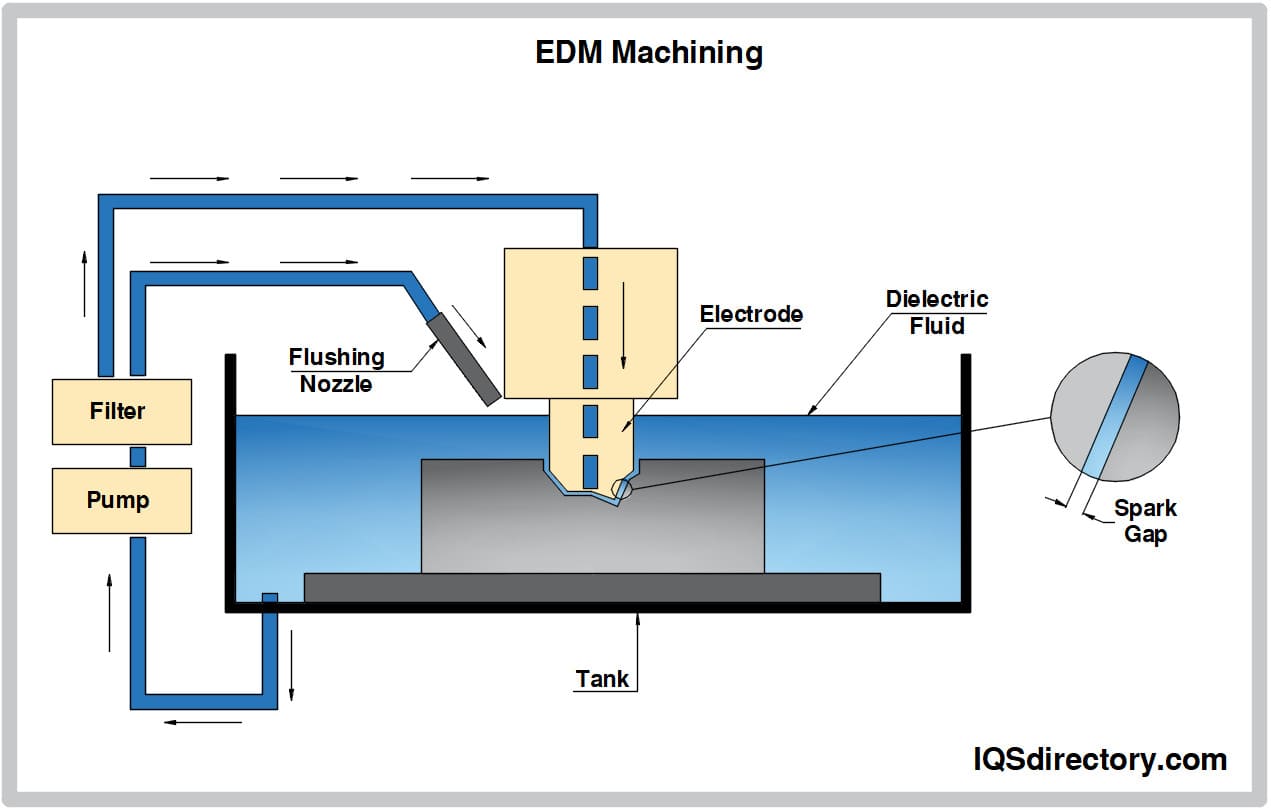 The basic funstions of an EDM machine to remove material using thermal energy.
The basic funstions of an EDM machine to remove material using thermal energy.
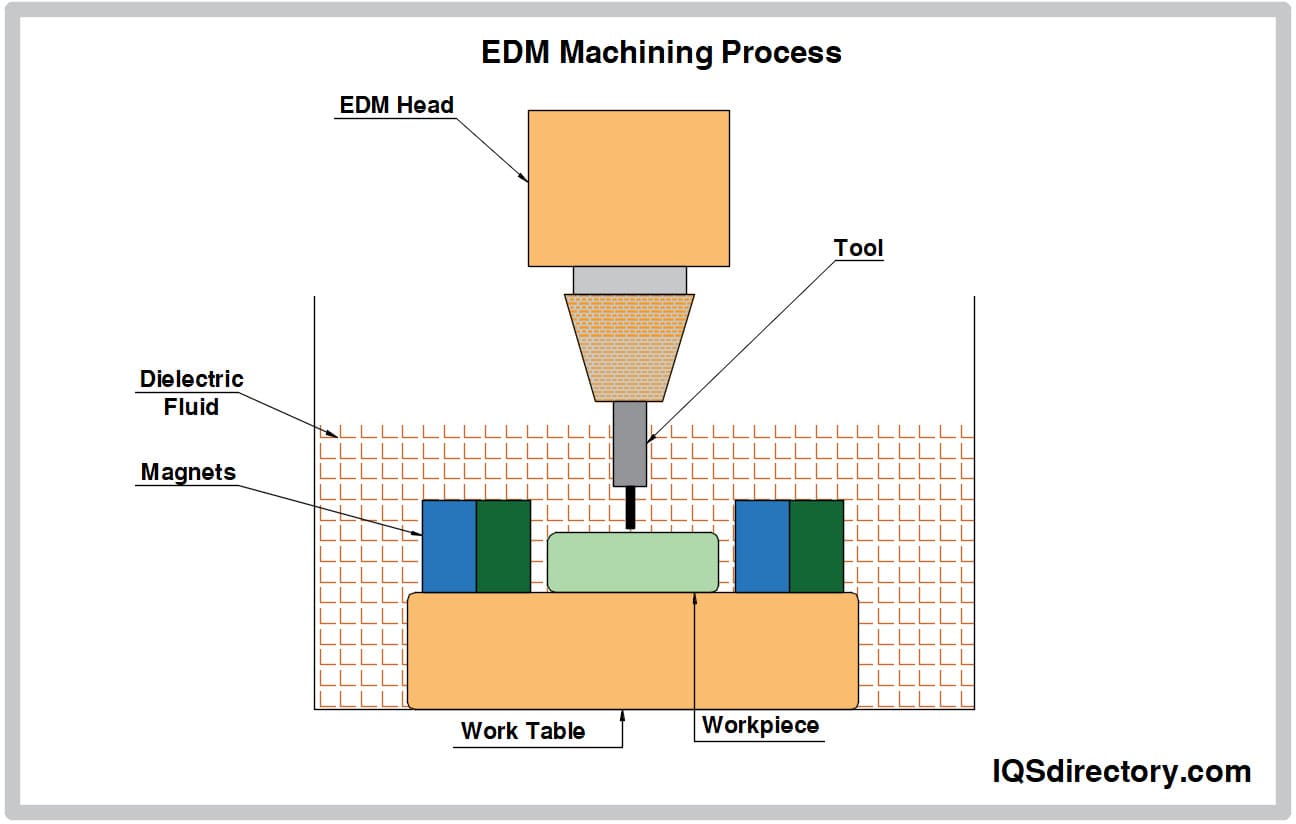 EDM machining process, the material is removed from the part to be machined and the electrode tool, the gap increases between the work and the tool, which must maintain a constant gap and arcing voltage to prevent a short circuit.
EDM machining process, the material is removed from the part to be machined and the electrode tool, the gap increases between the work and the tool, which must maintain a constant gap and arcing voltage to prevent a short circuit.
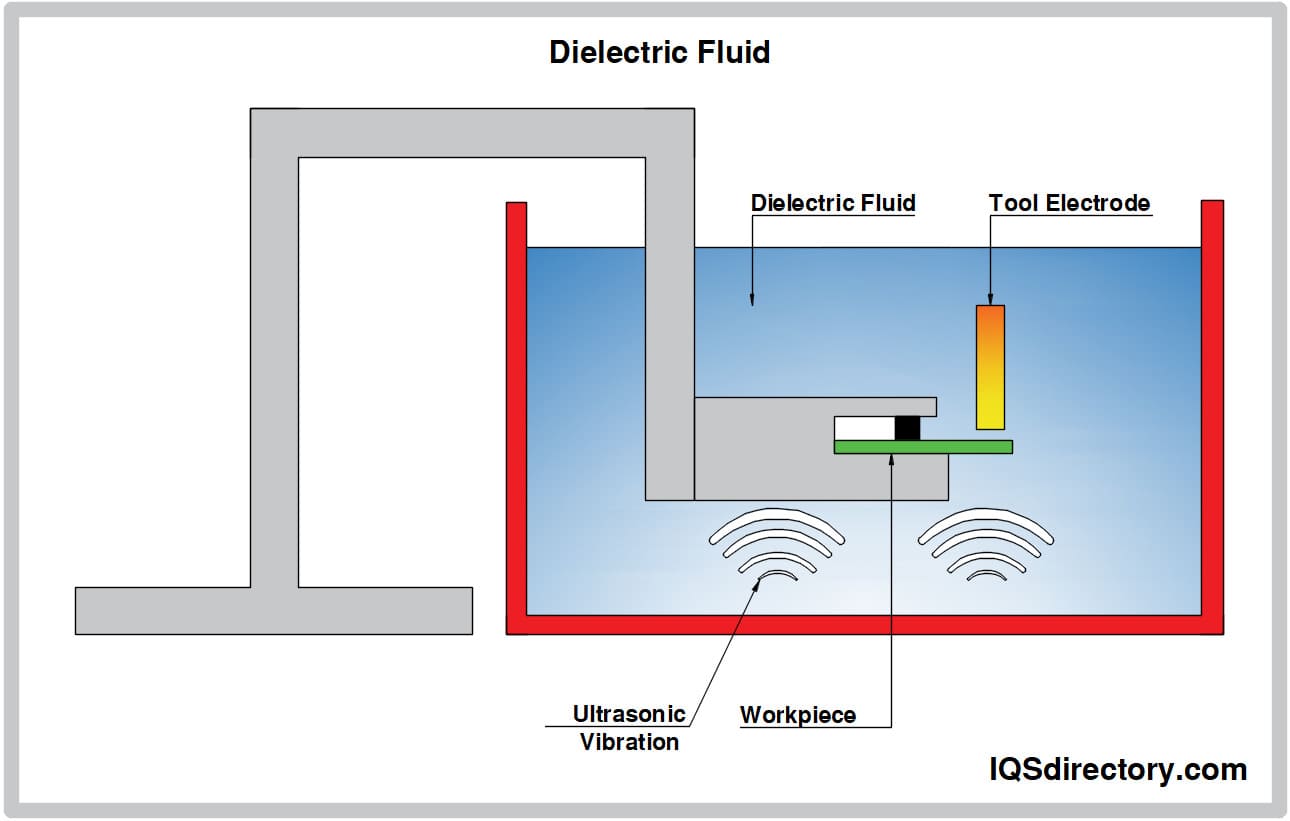 The different types of dielectric fluids are kerosene, paraffin oil, lubricating oil, transformer oil, or distilled water.
The different types of dielectric fluids are kerosene, paraffin oil, lubricating oil, transformer oil, or distilled water.
 A proper circulation of the dielectric fluid at the gap that is between the workpiece and electrode tool in EDM machining.
A proper circulation of the dielectric fluid at the gap that is between the workpiece and electrode tool in EDM machining.
 The tool and part machined, a spark is generated, in the presence of a dielectric medium, which removes material from the surface of the workpiece.
The tool and part machined, a spark is generated, in the presence of a dielectric medium, which removes material from the surface of the workpiece.
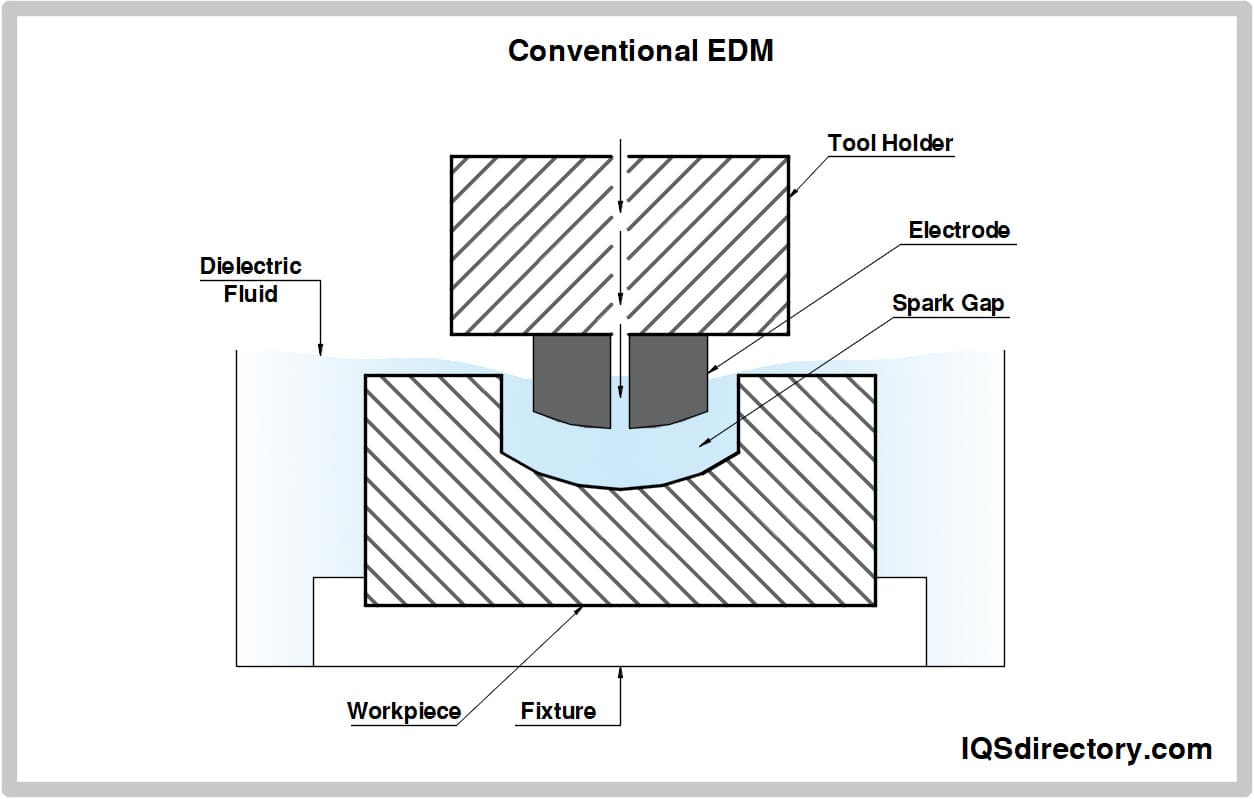 Conventional EDM makes use of machining to create a distinctive shape of an electrode, then sunk deep into the material to be machined.
Conventional EDM makes use of machining to create a distinctive shape of an electrode, then sunk deep into the material to be machined.
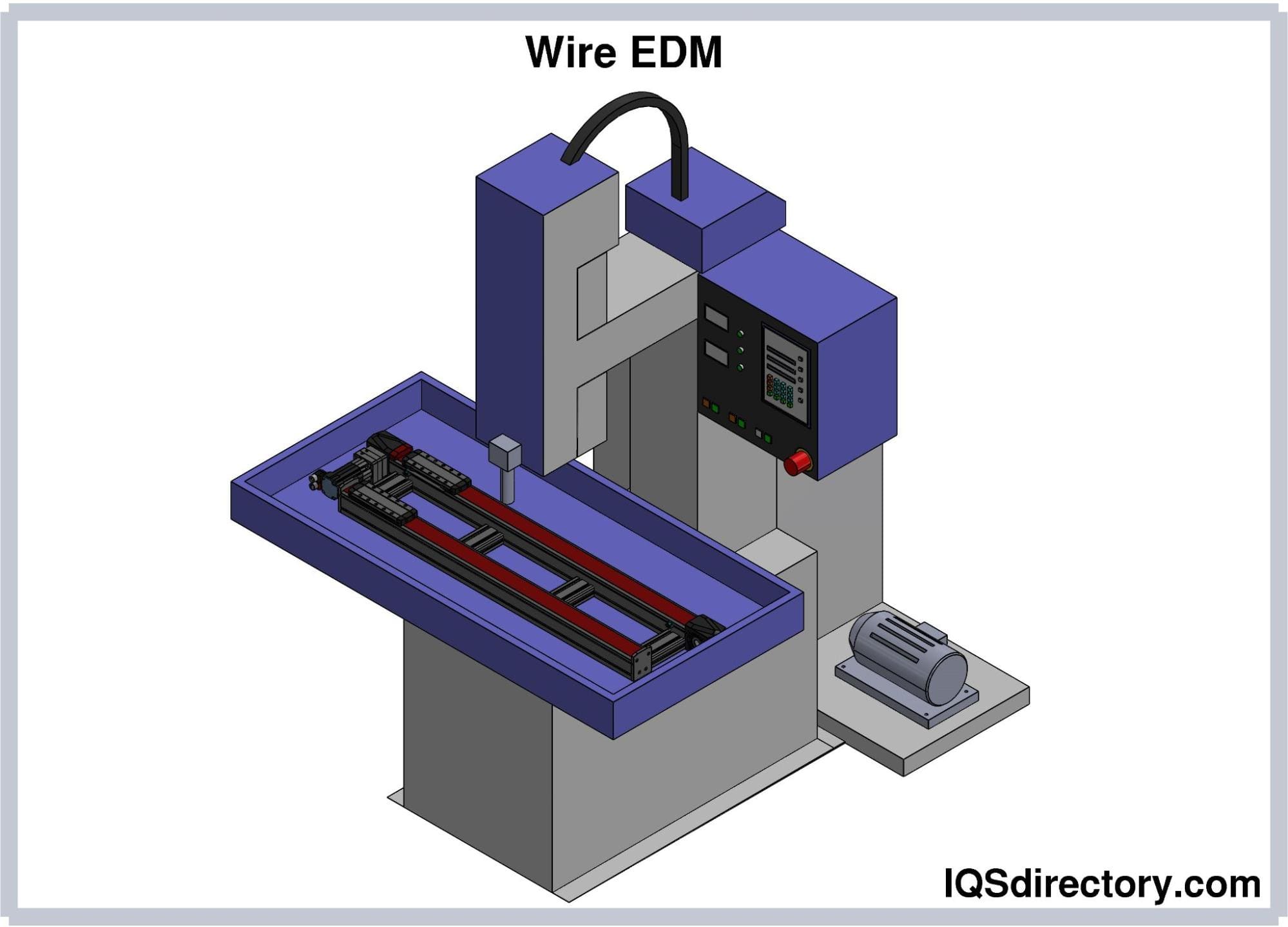 Wire EDM Machines uses deionized water to conduct electricity to cut through metal while preventing rust.
Wire EDM Machines uses deionized water to conduct electricity to cut through metal while preventing rust.
EDM Types
-
Double Rotating Electrodes
This EDM method employs rotating electrodes to erode a revolving workpiece. By adjusting the relative positions and angular velocities of both the workpiece and the electrode, different shapes can be created.
Electrical Discharge Grinding (EDG)
In this process, a rotating electrically conductive wheel acts as the electrode tool for electrical discharge erosion. EDG is an alternative method for sharpening diamond and carbide-tipped cutting tools, helping to reduce the high costs associated with diamond grinding wheels.
Electrical Discharge Machining (EDM)
This process uses a tool electrode to gradually transfer a mirror image of itself onto the workpiece, making small holes and precise shapes in electrically conductive materials.
Micro Electrical Discharge Machining (micro EDM)
A miniature ram-type machine that typically uses a diamond V-groove to spin the tool electrode up to 10,000 rpm. Electrode diameters as small as five microns can be used to produce micro-holes and other shapes in thin, electrically conductive materials.
Micro Wire EDM
This process uses a tungsten wire electrode with a diameter as small as 10µm to machine parts ranging from 0.1 to 1 mm in size. These tiny parts cannot be formed through conventional semiconductor processes. Specially designed wire movement systems, spark generators, and monitoring systems help control the low energy levels necessary for these operations.
Sinker EDM
Also known as plunge EDM> or ram EDM, this method removes metal by using rapid electrical discharges to erode the material.
Small Hole EDM
This process employs electrical discharges to create microscopic holes in materials.
Wire Electrical Discharge Machining (Wire EDM)
Wire EDM is a commonly used process in which a wire electrode moves longitudinally through the workpiece, eroding material along the path. A CNC machine with specialized software precisely controls the movement of the wire relative to the workpiece.
Hole Drilling EDM
The advantages of EDM make it ideal for specific hole-making applications. If a pilot hole has already been drilled, the wire can be threaded into it to finish the process using Wire EDM. In cases where a pilot hole is not present, a dedicated EDM hole-making machine is used. The Hole Drilling EDM (also called a "Hole Popper") utilizes a turning conductive tube as the electrode and continuous dielectric fluid flow to flush the cut. This method is also useful for creating the pilot hole needed for wire threading.
EDM Applications
-
Metal Disintegration Machining (MDM)
MDM machines are designed to remove broken tools from workpieces. The process is specifically intended to remove only the center of a bolt or stud, leaving the hole intact for further processing.
Small Hole Drilling
This process has various applications. For wire-cut EDM, it is used to create a hole in a workpiece through which the wire can be threaded for the wire-cut operation. A small hole drilling EDM head is mounted on a wire-cut machine and is used to remove large, hardened parts without the need for pre-drilling. It is commonly used to drill rows of holes at the beginning and end edges of turbine blades for jet engines. These holes allow gas to flow through, enabling the engine to operate at higher temperatures. Additionally, this method is employed to make spinnerets for synthetic fibers, among other applications.
Coinage Die Making
Coinage die making is used to produce dies for creating badges, jewelry, and for blanking or piercing operations. Typically, the positive master is made from sterling silver, as it is somewhat eroded during the process and is generally used only once. Once the master is used, the negative die is hardened and used with a drop hammer to produce stamped flat parts from cutout sheets.
Prototype Production
While the EDM process has traditionally been used in tool, mold, and die industries, it is increasingly being employed for producing prototype and production parts. This is especially true in industries such as aerospace, electronics, and automotive, where production quantities are relatively low.
EDM Materials
It is well-established that any workpiece to be machined with EDM must be electrically conductive, but there are additional material limitations to consider. Certain materials, such as high nickel alloys and carbide, can present challenges when using EDM. Solutions to these challenges typically involve adjusting the electrode material and opting for slower EDM cycle times.
EDM is a thermal process, which means it can potentially alter the metallurgy of the workpiece, creating zones affected by heat, micro-cracking, and recasting. However, EDM is known for being a stress-free machining process. Common materials used in EDM include brass, copper, copper tungsten, EDM graphite, and others.
When selecting electrodes, one of the key factors to consider is the material's resistivity and its ability to resist erosion.
Dielectric Fluid
A RAM EDM machine typically uses hydrocarbon oil as the dielectric fluid, which submerges both the workpiece and the spark. In contrast, wire EDM machines usually use deionized water, where only the sparking area is submerged. Regardless of whether the dielectric fluid is oil-based or water-based, it performs three essential functions: it maintains the correct spacing of the sparking gap between the electrode and the workpiece, cools the material to help form EDM chips, and removes the EDM chips from the sparking area.
Over time, the dielectric fluid degrades due to age or contamination, leading to potential instability in the discharge. While control electronics can help to some extent, the only effective solution is to continuously pump clean dielectric fluid through the cutting zone to flush out contaminants. As the fluid becomes more conductive with increased particle content, maintaining stable electrical thresholds in the sparking gap becomes more difficult.
The lifespan of dielectric fluid depends on various factors, including the type, quality, and efficiency of the EDM fluid filters. While there is no fixed expiration date, oil-based fluids should generally be replaced if they are more than five years old. A refractometer is the best tool to determine if the fluid needs replacement.
Choosing the right dielectric fluid involves considering several factors, such as the degree of metal removal, electrode wear, and particle suspension, among others.
Things to Consider When Choosing EDM
-
There are, of course, other ways to cut parts. When compared to conventional machining, electrical discharge machining (EDM) has its own set of advantages and disadvantages. Whether EDM is the best choice depends largely on the specifics of your application.
Some features of electrical discharge machining can help determine if it's the right process for your material. EDM is generally slower than other machining methods, but it offers more accuracy and predictability.
Considering Design To optimize the use of EDM, consider relaxing the surface finish requirements. This allows manufacturers to complete the part in fewer passes, resulting in a high metal removal rate and high current levels. Additionally, design the part so that the amount of stock removed by the machine is minimal. Use traditional techniques to remove the majority of the stock, leaving finishing operations to the EDM process. This approach significantly reduces both cost and time for each part.
Another design consideration is the use of fixtures. Many parts can be stacked and machined simultaneously, or a single part can undergo multiple EDM operations at once. When enlarging existing holes or reshaping them, through holes are preferable to blind holes, as they allow dielectric fluid to flow more easily through the machined area.
Considering Manufacturers As manufacturers expand their businesses, many are taking full advantage of new machinery that can help them succeed. EDM is a process that may not always be the first choice but, when its many benefits are understood, it can be a valuable option.
Look for a contract manufacturer with extensive experience and a reputation for excellent customer service. The right manufacturer will be confident in their ability to complete the job to your specifications and ensure customer satisfaction. Even though the equipment for EDM can require a significant investment, manufacturers should prioritize investing in high-quality EDM machines. Seek out manufacturers who are committed to delivering precision and quality in every project.
EDM Terms
-
Altered Metal Zone
A zone on a metal surface that has been mechanically altered by the EDM process.
Billet
An uncut block of graphite supplied by a manufacturer.
Burning
A colloquial term used to describe the EDM process.
Capacitor
An electrical device used to store electrical energy.
Center Flow
Dielectric fluid that is pumped through the workpiece or electrode for flushing purposes.
Crater
Small holes on the workpiece surface created by EDM sparks, also known as pits.
Dielectric Fluid
A non-conductive liquid that fills the space between the electrode and the workpiece, insulating them until the required voltage and gap are achieved. Once ionized, it becomes conductive, allowing current to flow to the workpiece, cooling the material and flushing away debris.
Diametrical Sparking Distance
The difference in size between the electrode and the crater it creates on the workpiece.
Discharge
The spark produced in the EDM process.
Edge Finder
An electrically operated tool used to precisely locate the workpiece in relation to the electrode. When the workpiece is within 0.0001 inches of the electrode, a signal or buzzer alerts the operator.
EDM Drilling
A specialized process that uses electrical energy in the form of sparks to create holes in metal parts.
EDM Machining
A process that shapes and forms metal parts using electrical energy.
Electrode
The tool used in the EDM process, made of electrically conductive material. The shape of the electrode mirrors the desired shape in the workpiece, with compensation for the overcut.
Eroding
The process of removing material through electrical discharge machining.
Finish
The surface texture resulting from the EDM process, typically measured as min Ra (U.S.).
Finish Cut
The final cut made on a workpiece. To achieve the desired finish and size, the rough cuts should leave just enough material for the finish cut to remove.
Flushing
The action of forcing dielectric fluid through the gap to remove debris created during the EDM process.
Gap Voltage
A measurement of the voltage across two points in a complete cycle: open gap voltage is measured across the electrode and workpiece before the spark, while working gap voltage is measured as the spark current discharges.
Graphite
One of the four types of carbon, commonly used as electrode material due to its high resistance to heat and ease of machining.
Heat Affected Zone (HAZ)
The area beneath the recast layer where metal properties change due to exposure to high heat.
Off-Time
The time interval between sparks during the EDM process.
Overcut
The difference in size between the electrode and the cavity, as an EDM crater is always larger than the electrode. Overcut can be measured as total overcut (diametrical overcut) or overcut per side.
Peak Current
The highest current available during each pulse from the power supply.
Recast Layer
A layer of material formed when melted metal solidifies on the surface of the workpiece.
Roughing (Hogging) Cut
An EDM method that removes the most material in the shortest amount of time.
Spark
The electrical discharge between two conductors during the EDM process.
Spark Gap
The space between the electrode and the workpiece at the point where the discharge occurs.
Spark Intensity
The energy contained in each spark during the EDM process.
Surface Finish
The smoothness or roughness of the machined surface, often measured in min Ra in the U.S.
Wear
The erosion of the electrode during the EDM process.
Workpiece
Any metal part subjected to the electrical discharge machining process.

